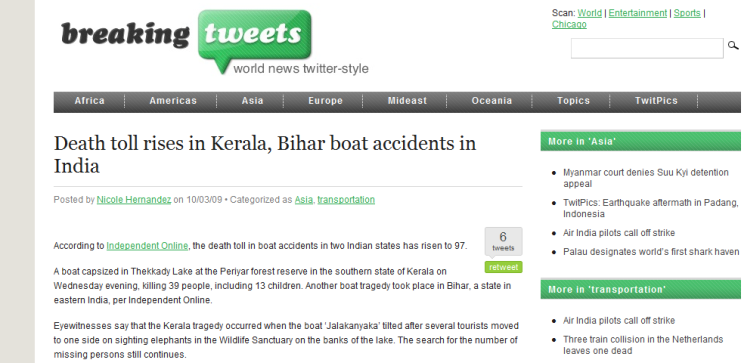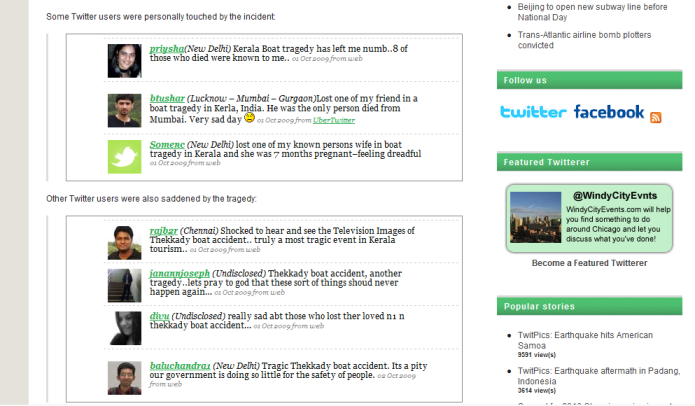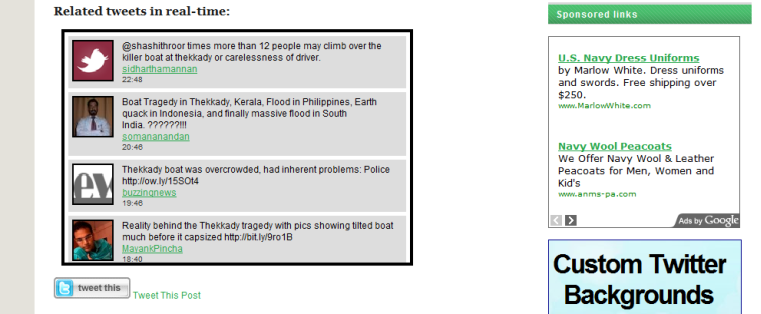Txtng news in 140 characters
It is no news to us that text messaging is morphing our modern culture. In 2008, the British scholar David Crystal has observed how text messages in mobile phones and IMs can influence our live technologically, sociologically, psychologically, commercially, and linguistically. In his book Txtng: The Gr8 Db8, Crystal points out that texting has become pervasive in many societies, and it also seemed to meet a new communicative need in a society where increased pressures on time and short attention spans are increasingly the norm[1]. A Cingular TV commercial in 2007, My bff Jill, provides an interesting angle to depict the text messaging culture in our modern society:
A key feature of today’s micro-blogging services (i.e. Twitter and Plurk) is its 140-character limitation, 20 characters less than a short message service (SMS) on a mobile phone. As our technology is pursuing less and less words for communication, we should understand how this application will affect people’s literacy. A good example of how an aphoristic-style way of communication is changing our culture can be found on BreakingTweet.com, a Twitter-style news website built in January 2009.
Breaking Tweets is an independent news site that puts a spin on world news through the use of Twitter. The philosophy behind the site is “hyperlocal gone global.” There is an emphasis on what is happening in a specific place at a specific time and looks at how people are reacting to that event(s) in the area.
The format of a Breaking Tweet news article usually contains the following three parts:
1. Twitter-style news: a piece of news summary less than 140 words

2. Tweets quoted as a news source: generally each story links to a media outlet of authority for brief background information on the news topic and for those seeking more information[2].However, relevant tweets are always provided in a Twitter-Style news page.

3 . Tweets in real-time: the latest tweets which are talking about the news

The law of brevity in Twitter-style news
Before we look forward, it is necessary for us to realize that ample historical instances have shown that the use of short messages to the masses can be influential. Back in the fourteenth centuries, a Chinese farmer Yuan-Cheng Chu secretly inserted paper slips into moon cakes (a kind of Chinese desserts giving out only on the 15th of August in the Lunar Calendar for celebration) in order to topple the Mongolian regime; on the paper there were only seven simple Chinese characters to inform people the date for revolution. Unexpectedly by the aid of those short text messages, the revoltionists successfully expelled the Mongolians and founded a new dynasty. The distribution of text messages for political revolution is also not unfamiliar to our modern society: In 2001, SMS messages directed 700,000 demonstrators to Manila’s People Power shrine to demand the removal of then President Joseph Estrada, who stepped down in favor of his Vice President, Gloria Macapagal Arroyo[3], as well as the more recent Iranian protest dubbed as the Twitter revolution by key media in 2009[4].
Not only historical lessons, but scientific research has also confirmed the law of brevity in human language, according to which the most frequently-used words tend to be the shortest[5]. Perhaps the above may help explain why the feature of 140-character limitation in micro-blogging services can be popular and widely-accepted.
In regards of news reporting, the use of brevity is nothing fresh to traditional print news media– brevity is commonly used in news headlines, news subtitles, news summary, or photo captions in order to lead readers to systemize all the text; brevity can help readers filter relevant news easily, and guide readers’ visual attention to the complete coverage.
Back to the BreakingTweet.com, however, its use of brevity goes beyond visual attention and reaches to the text in news articles. When the news text is produced in a Twitter-style 140-character limitation, several problems arise. First, news neutrality cannot be guaranteed in the editing process. By referring to a recognizable online news source, most of the time Breaking Tweet editors can only provide a single point of view, while in the original news coverage usually contains views of pros and cons either in an average of 700~900 words of article, or in an one-minute length of video footage. Take the news of Rio de Janeiro wins the 2016 Olympics on Breaking Tweet for example, it writes about the festive reaction of Rio, yet totally ignores the other candidate cities like Madrid which is mentioned in the original new source from BBC.
Second, because of 140-character limitation, Breaking Tweet articles are supported not by more words, but by Twitter users’ related past response and updates. According to Breaking Tweet, ‘Tweets are manually selected by editors based on relevance and arranged to tell a story in a journalistic style. Those with pictures, videos, and/or eyewitness accounts from the scene are priority, while tweets with instant reaction to the news are also selected[6].’ Since tweets become an important news sources for production, it is therefore reasonable to assume that news selection of topics is based on the popularity Twitter user’s preference, participation, and discussion. Under such circumstance, Breaking Tweet would never achieve its mission to ‘help people enhance their worldview or perspective of global events[7]’; instead, the news site would reflect nothing but Twitter users’ existing point of view.
In conclusion, in a Twitter-style news website like BreakingTweet.com, news neutrality is sacrificed for brevity, and news selection is ceded to Twitter user’s involvement. While new technology such as SMS and micro-blogging can echo to people’s natural tendency for language brevity, at the same time human beings’ literacy and information retrieval are also experiencing major transformations: the influences are more than a change of writing style, but also how people absorb information and observe the world.
[1] David Crystal, Txtng: The Gr8 Db8 (Oxford: 2008). P. 95
[2] http://www.breakingtweets.com/about/
[3] U Say U Want A Revolution, http://www.time.com/time/magazine/article/0,9171,660984,00.html. Retrieved 4 Oct 2009
[4] EDITORIAL: Iran’s Twitter revolution, http://www.washingtontimes.com/news/2009/jun/16/irans-twitter-revolution/. Retrieved 4 Oct 2009
[5] Human Language And Dolphin Movement Patterns Show Similarities In Brevity, http://www.sciencedaily.com/releases/2009/07/090730073915.htm#. Retrieved 4 Oct 2009
[6] http://www.breakingtweets.com/about/
[7] ibid